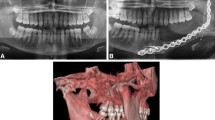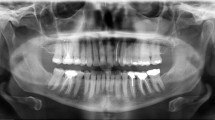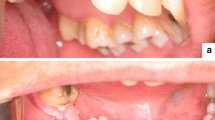Abstract
Background
Pigmented intraosseous odontogenic lesions are rare with only 47 reported cases in the English literature. Among them, pigmented calcifying cystic odontogenic tumor, formerly known as calcifying odontogenic cyst, is the most common lesion with 20 reported cases.
Methods
A case of pigmented calcifying cystic odontogenic tumor associated with odontoma occurring at the mandibular canine-premolar region of a young Japanese boy is presented with radiographic, and histological findings. Special staining, electron microscopic study and immunohistochemical staining were also done to characterize the pigmentation.
Results
The pigments in the lesion were confirmed to be melanin by Masson-Fontana staining and by transmission electron microscopy. The presence of dendritic melanocytes within the lesion was also demonstrated by S-100 immunostaining.
Conclusion
The present case report of pigmented calcifying cystic odontogenic tumor associated with odontoma features a comprehensive study on melanin and melanocytes, including histochemical, immunohistochemical and transmission electron microscopic findings.
Similar content being viewed by others
Background
Pigmented odontogenic lesions are rare, with only 47 cases reported in English literature since 1961 [Table 1]. Most of these pigmented lesions were found in racially pigmented patients. This is a case report of a pigmented calcifying cystic odontogenic tumor (CCOT) with special, ultrastructural and immunohistochemical findings together with a brief review of the English literature on pigmented odontogenic lesions especially pigmented CCOT.
Case presentation
A 15-year-old Japanese boy was referred to the Okayama University Hospital by the orthodontist for management of a mixed radiolucent and radiopaque lesion in the left mandibular canine-premolar region detected during routine radiographic examination. The lesion was asymptomatic and the patient's medical and family histories were non-contributory.
On intraoral examination, there was no bony expansion and the overlying mucosa was also normal. Panoramic radiograph showed a well-defined unilocular radiolucent lesion with distinct sclerotic margin containing radiopaque masses [Fig. 1] and CT scan revealed that the lesion was lingual to the left mandibular canine. The lesion was small and the radiodensities of the included masses were comparable to that of the adjacent teeth. An initial diagnosis of odontoma was made, and surgical excision was performed under local anesthesia. Follicle-like tissue encapsulating three pieces of small calcified masses, was obtained from the surgical procedure.
Microscopic examination of the soft tissues revealed dental follicle-like loose connective tissue lined by a non-keratinized stratified epithelium of uneven thickness. The thickest portion of the epithelium showed basal cuboidal ameloblast-like cells and suprabasal stellate-like cells [Fig. 2]. Few round or drop-like calcifications were also observed focally within the epithelial lining.
Among the three calcified masses, two were small organoid denticles composed of enamel matrix, well-developed tubular dentin and pulp-like tissues with intervening loose connective tissues [Fig. 2, inset]. Ghost cells characterized by pale staining and ballooning cytoplasms and shadowy nuclei were seen within the odontogenic epithelium lining the enamel surface of the denticles as well as within calcified matrix. The other decalcified mass was an aggregate of ghost cells showing various degrees of dystrophic calcification. Focal and diffuse dark brown pigmentations, judged to be melanin granules, were recognized within the epithelial cells, connective tissue surrounding the denticles and also in the cytoplasms of ghost cells undergoing dystrophic calcification.
The melanin granules were confirmed by Masson-Fontana staining [Fig. 3] and melanosomes were detected by transmission electron microscopy (TEM) [Fig. 4, Fig. 5]. S-100 immunostaining revealed the presence of dendritic melanocytes within the ghost cell aggregates [Fig. 6].
Discussion
A final diagnosis of pigmented CCOT associated with compound odontoma was undertaken due to the presence of well-developed denticles within the small cystic structure lined by typical odontogenic epithelium based on the criteria for the diagnosis of CCOT by the World Health Organization [1]. Reviews on pigmented odontogenic lesions [2–4] together with case reports from our literature search [5–8], revealed 47 cases. All these reported cases are summarized in Table I in order of abundance. The most commonly recognized pigmented odontogenic lesion is calcifying odontogenic cyst (COC), recently renamed as CCOT [1] with 20 reported cases [Table 2].
Among those pigmented CCOTs, 5 were associated with odontomas, 2 compound type and 3 complex or composite odontomas. All cases were intraosseous lesions and 10 out of 20 cases included special staining for melanin but only one with TEM examination. The present case report of pigmented CCOT associated with odontoma (CCOTaO) features a comprehensive study on melanin and melanocytes with special and immunohistochemical staining together with identification of melanosomes by TEM.
The exact etiology of melanin pigmentation in intraosseous odontogenic lesions is unknown, leaving room for speculation. As described in previous reports, most of the patients were Blacks and Asians, thereby implicating racial pigmentation to be an important factor [2, 4]. Melanocytes, normally present in the oral mucosa, are also found in the dental lamina or tooth bud of the fetuses more commonly in pigmented race [9]. Odontogenesis is a complex process resulting from the reciprocal and close interactions between oral epithelium and cranial neural crest-derived ectomesenchyme [10]. It might not be surprising that melanocytes, which are also of neural crest in origin, may be present in dental lamina and odontogenic lesions. Another possibility is that a few proportion of lesional odontogenic tissue could have potential for neuroectodermal differentiation under certain circumstances. It is also rational to speculate that the quantity of melanocytes and the conditions or predisposing factors activating them for melanin production might be associated with racial pigmentation. Further studies are necessary to prove or refute these possibilities.
Although the 2005 WHO classification includes CCOT as a benign odontogenic neoplasm [1], CCOT features heterogenous histologic spectrum ranging from cystic to solid structure, and exhibits a variety of clinico-pathologic and behavioral characters [11, 12]. Because of the diverse clinico-histologic features and the various neoplastic potential, there have been disagreements on the terminology as well as whether to classify CCOTs as a cyst or a neoplasm. Moreover, CCOT is frequently associated with other lesions such as odontoma, ameloblastoma and ameloblastic fibroma, and the most common of these is the CCOTaO [11, 12]. The prevalence of CCOTaO was reported in 17.4% of 92 cases by Hong [11], 23.8% of 21 cases by Li TJ [12] and 35% of 215 cases by Buchner [13]. A concensus still lacks on the classification of CCOTaO either as a separate type of CCOT, i.e., combined odontogenic lesion with some proliferative potential [14, 15] or as a sub-type of non-proliferative simple unicystic type of CCOT. Hirshberg analyzed 52 cases of CCOTaO and proposed CCOTaO to be regarded as a separate entity and suggested the term "odontocalcifying odontogenic cyst", due to the unique histologic features and its female predilection with the predominant distribution pattern to the maxilla [14]. However, it is generally accepted that CCOTaO occurs in a significantly younger age group compared to other types [11, 14, 17].
Pigmented compound odontoma was considered as a differential diagnosis because of the presence of ghost cells with subsequent calcification and that the occurrence of odontogenic epithelium is not rare in odontomas [18–20]. Combination lesions should also be anticipated because the odontogenic epithelium in different areas might undergo variable degrees of differentiation and degeneration [21]. In reality, the differentiation of CCOTaO from odontoma is difficult and subjective for some cases. There seems to be a mere difference in clinical behavior and growth potential between these two lesions and the controversy is merely of academic interest. The treatment for both lesions is conservative enucleation and the recurrence is very rare.
Conclusion
This is a case of pigmented CCOTaO with comprehensive studies on melanin pigments that will add to the rare literature of pigmented odontogenic lesions. All the reported cases of pigmented intraosseous odontogenic lesions in the English literature since 1961, especially pigmented CCOT, were reviewed and summarized for academic purpose.
Abbreviations
- Calcifying cystic odontogenic tumor (CCOT):
-
Calcifying cystic odontogenic tumor associated with odontoma (CCOTaO), Calcifying odontgenic cyst (COC)
References
Barnes L, Eveson JW, Reichart P, Sidransky D, (Eds.): World Health Organization Classification of Tumors. Pathology and Genetics of Head and Neck Tumors. 2005, IARC Press: Lyon, 283-327.
Buchner A, David R, Carpenter W, Leider A: Pigmented lateral periodontal cyst and other pigmented odontogenic lesions. Oral Dis. 1996, 2: 299-302.
Takeda Y, Sato H, Satoh M, Nakamura S, Yamamoto H: Pigmented ameloblastic fibrodentinoma: a novel melanin-pigmented intraosseous odontogenic lesion. Virchows Arch. 2000, 437: 454-458. 10.1007/s004280000249.
Takeda Y, Yamamoto H: Case report of a pigmented dentigerous cyst and a review of the literature on pigmented odontogenic cysts. J Oral Sci. 2000, 42: 43-46.
Siar CH, Ng KH: Melanin Pigment in Calcifying Odontogenic Cysts. Singapore Dent J. 1987, 12: 39-42.
Takeda Y: Melanocytes in malignant ameloblastoma. Pathol Int. 1996, 46: 777-781.
Üzüm N, Akyol G, Asal K, Köybaşioğlu A: Ameloblastic carcinoma containing melanocyte and melanin pigment in the mandible: a case report and review of the literature. J Oral Pathol Med. 2005, 34: 618-620. 10.1111/j.1600-0714.2005.00306.x.
Ijiri R, Onuma K, Ikeda M, Kato K, Toyoda Y, Nagashima Y, Ito Y, Abiko Y, Tanaka Y: Pigmented intraosseous odontogenic carcinoma of the maxilla: a pediatric case report and differential diagnosis. Hum Pathol. 2001, 32: 880-884. 10.1053/hupa.2001.26475.
Lawson W, Abaci IF, Zak FG: Studies on melanocytes. V: The presence of melanocytes in the human dental promordium: an explanation for pigmented lesions of the jaws. Oral Surg Oral Med Oral Pathol. 1976, 42: 375-380. 10.1016/0030-4220(76)90171-7.
Sharpe PT: Neural crest and tooth morphogenesis. Adv Dent Res. 2001, 15: 4-7.
Hong SP, Ellis GL, Hartman KS: Calcifying odontogenic cyst. A review of ninety-two cases with reevaluation of their nature as cysts or neoplasms, the nature of ghost cells and subclassification. Oral Surg Oral Med Oral Pathol. 1991, 72: 56-64. 10.1016/0030-4220(91)90190-N.
Li TJ, Yu SF: Clinicopathologic spectrum of the so-called calcifying odontogenic cysts: a study of 21 intraosseous cases with reconsideration of the terminology and classification. Am J Surg Pathol. 2003, 27: 372-384. 10.1097/00000478-200303000-00011.
Buchner A: The central (intraosseous) calcifying odontogenic cyst: an analysis of 215 cases. J Oral Maxillofac Surg. 1991, 49: 330-339.
Hirshberg A, Kaplan I, Buchner A: Calcifying odontogenic cyst associated with odontoma: a possible separate entity (odontocalcifying odontogenic cyst). J Oral Maxillofac Surg. 1994, 52: 555-558.
Takata T, Lu Y, Ogawa I, Zhao M, Zhou ZY, Mock D, Nikai H: Proliferative activity of calcifying odontogenic cysts as evaluated by proliferating cell nuclear antigen labeling index. Pathol Int. 1998, 48: 877-881.
Toida M: Proliferative activity and subtyping of calcifying odontogenic cyst. Pathol Int. 2000, 50: 81-83. 10.1046/j.1440-1827.2000.01009.x.
Praetorius F, Hjorting-Hansen E, Gorlin RJ, Vickers RA: Calcifying odontogenic cyst. Range, variations and neoplastic potential. Acta Odontol Scand. 1981, 39 (4): 227-240.
Miki Y, Oda Y, Iwaya N, Hirota M, Yamada N, Aisaki K, Sato J, Ishii T, Iwanari S, Miyake M, Kudo I, Komiyama K: Clinicopathological studies of odontoma in 47 patients. J Oral Sci. 1999, 41 (4): 173-176.
Chang JY, Wang JT, Wang YP, Liu BY, Sun A, Chiang CP: Odontoma: a clinicopathologic study of 81 cases. J Formos Med Assoc. 2003, 102: 876-882.
Kerebel B, Kerebel LM: Ghost cells in complex odontoma: A light microscopic and SEM study. Oral Surg Oral Med Oral Path. 1985, 59: 371-378. 10.1016/0030-4220(85)90062-3.
Abrams AM, Howell FV: The calcifying odontogenic cyst; report of four cases. Oral Surg Oral Med Oral Pathol. 1968, 25: 594-606. 10.1016/0030-4220(68)90305-8.
Acknowledgements
This work was supported by Grants-in-Aid for Scientific Research (B) No.17406027 and (C) No.19592109 from the Japanese Ministry of Education, Culture, Sports, Science and Technology. Written consent for publication was obtained from the patient or their relative.
The authors would like to thank Ms. Yoshiko Kurashige and Mr. Tadao Zoda for their expert technical assistances in histological and electron microscopic preparations and Dr. Rosario Santos Rivera for her great help in manuscript editing.
Author information
Authors and Affiliations
Corresponding author
Additional information
Competing interests
The author(s) declare that they have no competing interests.
Authors' contributions
PPH, HN, CHS carried out the case study, discussed and reviewed the literature and prepared the manuscript. MG, RT and NN participated in the discussion and review process and also in critical revision of the manuscript. SB and KN helped in data collection and reviewing of the literature. All the authors have read and approved the manuscript.
Authors’ original submitted files for images
Below are the links to the authors’ original submitted files for images.
Rights and permissions
Open Access This article is published under license to BioMed Central Ltd. This is an Open Access article is distributed under the terms of the Creative Commons Attribution License ( https://creativecommons.org/licenses/by/2.0 ), which permits unrestricted use, distribution, and reproduction in any medium, provided the original work is properly cited.
About this article
Cite this article
Han, P.P., Nagatsuka, H., Siar, C.H. et al. A pigmented calcifying cystic odontogenic tumor associated with compound odontoma: a case report and review of literature. Head Face Med 3, 35 (2007). https://doi.org/10.1186/1746-160X-3-35
Received:
Accepted:
Published:
DOI: https://doi.org/10.1186/1746-160X-3-35










